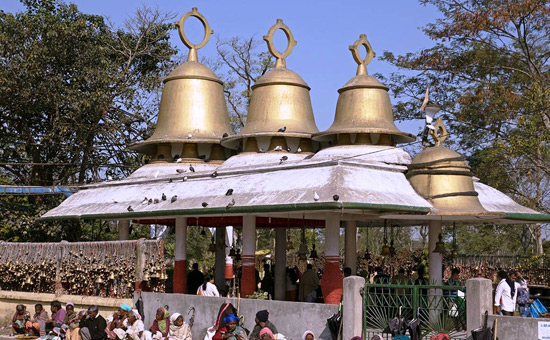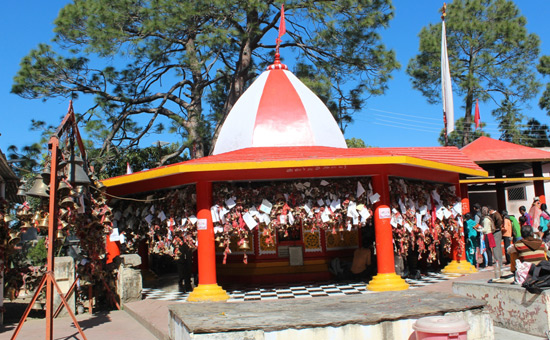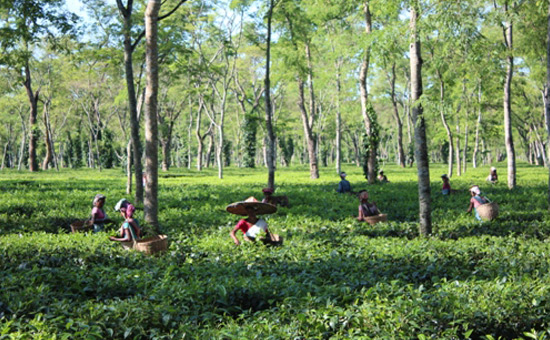Assam is a beautiful state
of India situated south of the eastern Himalayas along the Brahmaputra and Barak River valleys. It has
many hidden treasures.
One such treasure is the Tilinga Mandir or Bell Temple, dedicated
to Lord Shiva. He is depicted as a Yogi living in Mount Kailash,
Tibet with his wife Parvati and two sons and most worshiped in the aniconic
form of the Lingham.
The Tilinga Mandir is a very famous Shiv temple in ‘Bordubi’ i.e. 7 km from Tinsukia District (the last district of upper Assam). The temple is in a tea garden at Bordubi with bells hanging all around the temple complex.
The bells are made of bronze, brass, copper and even aluminium. The word ‘Tilinga’ means ‘bell’ in Assamese and ‘Mandir’ means ‘temple’. As compared to other sites this is a relatively new place of pilgrimage but important nevertheless.
We do not find any statue or
idols in this temple. Also there are no touts, shops, loudspeakers belting out
devotional songs, and traffic jam. What exists is a hidden
Shiva Linga beneath a banyan tree, considered sacred and holy, and thousands of bells hanging with chanting of the
mystical powerful note Om Namah Shivay.
We find the largest collection of bells in this temple. It has made it to the Limca Book of World Records for hosting the largest collection of bells and of all types. There are hundreds and thousands of bells in bronze, brass, copper and aluminium. These are tied to the big peepal or banyan tree and on its branches.
According to Hindu tradition, banyan trees are considered ‘kalpavriksha’ or wish fulfilling divine trees. It is believed that if you have a wish and pray to Lord Shiva, your wish would be granted. The only condition being you have to donate a bell at this temple.
 Note bell shaped domes size, biggest on left smallest on right. Pic by Author.
Note bell shaped domes size, biggest on left smallest on right. Pic by Author.
The temple roof consists of four giant bells. At temple entrance is a metallic bell, devotees ring the bell and enter the temple. Devotees throng the temple continuously but it is on Monday, considered to be the day when devotees worship Shivji, that one sees maximum crowds. On Mahashivratri one sees even larger crowds.
If you are visiting ‘Tilinga Mandir’ for the first time Monday should be the day. The temple is also visited by large number of young boys and girls, who pray together asking that their relationship lasts long.
 Golu Devta Mandir Chitai near Almora, Kumaon Uttarakhand. Pic by S Nayyar.
Golu Devta Mandir Chitai near Almora, Kumaon Uttarakhand. Pic by S Nayyar.
The offering of bells is also found at Golu Devta Mandir near Almora. Here devotees write down their wishes, many a time on stamp paper, as if it were an affidavit. Temple is full of bells.
When we talk of the Tilinga Mandir and Bordubi Tinsukia, we cannot forget the tea tribes. These tribes were brought by the British from modern day Jharkhand and around to work as labourers in tea gardens. They are found in every district of Assam. Earlier generations of tribes were not educated but things are changing with younger generation being better educated.
Karam Puja is the most important festival of the tea tribe communities of Assam. During the festival is worshipped “Mother Earth”- the goddess of creation. It is celebrated in mid-August on the night of ‘Bhado
Ekadasi’ and is basically an agriculture related festival. Their famous dance performed on the night of Karam Puja is known as ‘Jhumair Nritya’. It is essentially a group dance performance accompanied by the rhythm of ‘Dhol’ and ‘Madal’ and performed by young men and women.
History of Tilinga Mandir
This temple is nearly half a century old. In 1965, tea garden workers of this area noticed a ‘Shiv Linga’ that had emerged from the ground near this banyan tree. The administrators of the garden suggested that a small temple be built here.
Initially when people came to pray here, they promised to come back and present a bell to this temple if their prayers are answered. It was a matter of faith. As the number of devotees whose prayers were answered increased more people started visiting and praying for wish fulfilment. They tied a bell on the arms of this grand tree when their prayers were answered.
Many people even present a pigeon to this temple when their wishes are fulfilled. It is generally a norm or belief that people either tie a bell or a trishul or present a pigeon at this temple after their wishes are fulfilled. The pigeons fly away.
The fame of this temple has spread far and wide. It attracts thousands of devotees from all over India. They come, make a prayer and tie a bell to the banyan tree.
In the beginning, the temple
had only the Banyan (peepol) tree with the grounded Shiva Linga and a boundary
wall. With time devotees created a beautiful temple that has three bell shaped
domes lined up in decreasing order in context of size from left to right.
Bells of all sizes and weight hang in the temple’s premises. The weight of a small bell could be 5 grams and the heavy one is 55 kilo. Some bells get rusty with time whilst
others shine like gold in the sun.
Bells are stringed together
in heaps from iron bars, creating unintentionally, a sculptural bouquet. Each bell represent a wish
fulfilled. There are so many bells, year after year the number of bells
only keeps increasing. Some bells fall off but the temple authorities keep
them. They store them in a large bags that are storied on temple premises.
This temple is as spiritually and mystically strong as any other temple. Close to the mystical tree are more than a hundred Shiva tridents (trishul) carelessly speared into the sand.
Temple surroundings are serene and beautiful. The Tilinga Mandir, also known as the Shiva Mandir is for
the spiritually inclined.
I must end by saying this beautiful
temple is a must visit place. Over the years this temple has become a popular
tourist destination.
Closest Airport: Mohanbari airport located at
Dibrugarh district ie Dibrugarh Airport. There are flights from Kolkata to
Dibrugarh. The temple is about 50 kms from the airport.
Train: The nearest railway station is Tinsukia Railway Station. It takes 30 minutes from the station to the temple by either bus or taxi.
The drive to Bordubi from Tinsukia or Dibrugarh district is a delight. Lush green tea gardens, see tea leaves being plucked and inhale the aroma of tea wafting from the factories around. The endless stretches of gardens are a joy to see.
 Tea garden Dibrugarh. Pic by S Nayyar
Tea garden Dibrugarh. Pic by S Nayyar